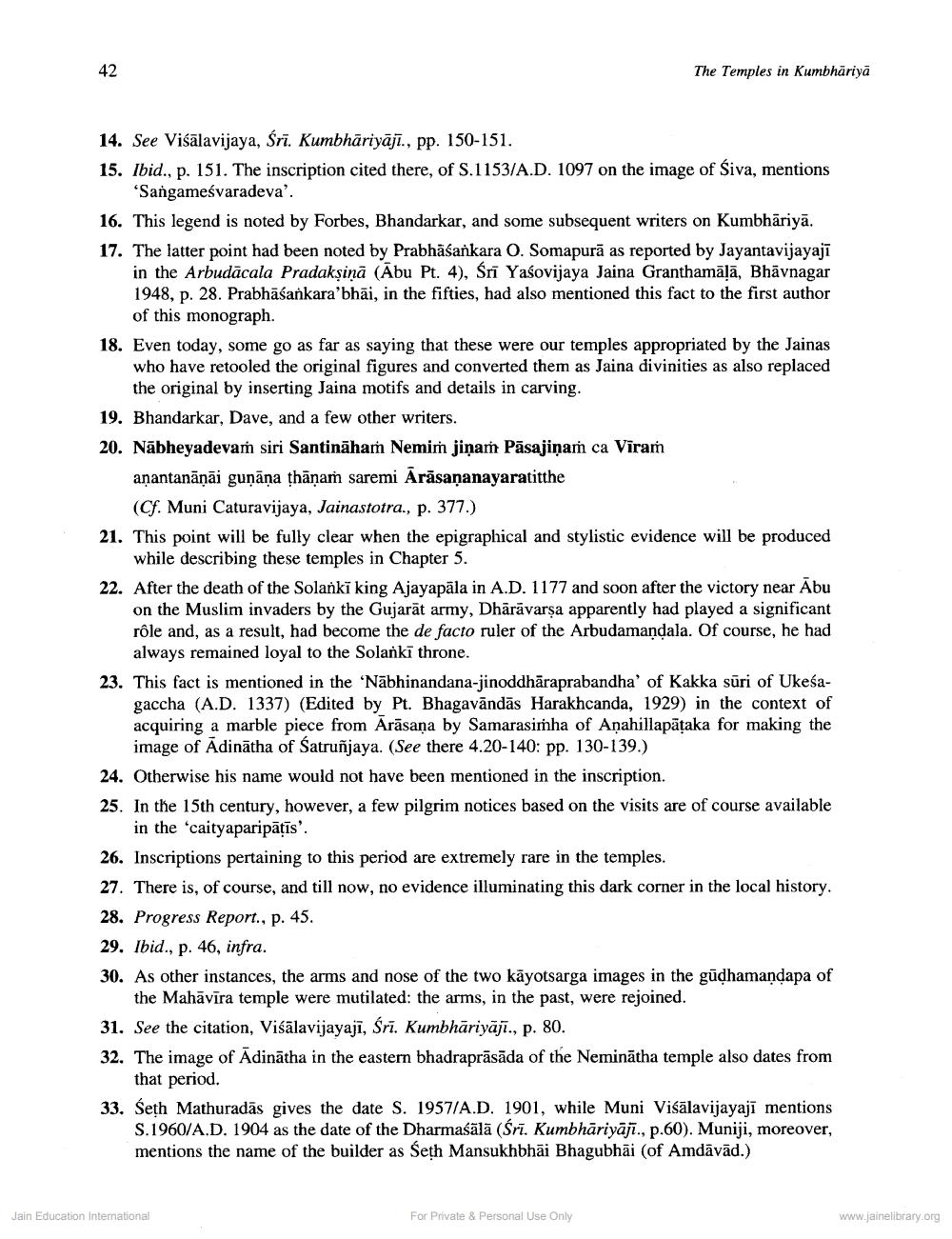________________
The Temples in Kumbhariya
14. See Viśālavijaya, Śrī. Kumbhāriyājī., pp. 150-151. 15. Ibid., p. 151. The inscription cited there, of S.1153/A.D. 1097 on the image of Siva, mentions
'Sangamesvaradeva'. 16. This legend is noted by Forbes, Bhandarkar, and some subsequent writers on Kumbhāriyā. 17. The latter point had been noted by Prabhāśankara O. Somapurā as reported by Jayantavijayaji
in the Arbudācala Pradakşiņā (Abu Pt. 4), Sri Yasovijaya Jaina Granthamālā, Bhāvnagar 1948, p. 28. Prabhāśankara'bhāi, in the fifties, had also mentioned this fact to the first author
of this monograph 18. Even today, some go as far as saying that these were our temples appropriated by the Jainas
who have retooled the original figures and converted them as Jaina divinities as also replaced
the original by inserting Jaina motifs and details in carving. 19. Bhandarkar, Dave, and a few other writers. 20. Nābheyadevam siri Santināham Nemim jiņam Pāsajiņam ca Vīram
anantanāņāi gunāņa țhānaṁ saremi Ārāsaņanayaratitthe
(Cf. Muni Caturavijaya, Jainastotra., p. 377.) 21. This point will be fully clear when the epigraphical and stylistic evidence will be produced
while describing these temples in Chapter 5. 22. After the death of the Solanki king Ajayapāla in A.D. 1177 and soon after the victory near Abu
on the Muslim invaders by the Gujarāt army, Dhārāvarsa apparently had played a significant rôle and, as a result, had become the de facto ruler of the Arbudamandala. Of course, he had
always remained loyal to the Solanki throne. 23. This fact is mentioned in the 'Nābhinandana-jinoddhāraprabandha' of Kakka sūri of Ukeśa
gaccha (A.D. 1337) (Edited by Pt. Bhagavāndās Harakhcanda, 1929) in the context of acquiring a marble piece from Arāsaņa by Samarasimha of Anahillapäțaka for making the
image of Adinātha of Satruñjaya. (See there 4.20-140: pp. 130-139.) 24. Otherwise his name would not have been mentioned in the inscription. 25. In the 15th century, however, a few pilgrim notices based on the visits are of course available
in the 'caityaparipāțīs' 26. Inscriptions pertaining to this period are extremely rare in the temples. 27. There is, of course, and till now, no evidence illuminating this dark corner in the local history. 28. Progress Report., p. 45. 29. Ibid., p. 46, infra. 30. As other instances, the arms and nose of the two kāyotsarga images in the gūdhamandapa of
the Mahāvīra temple were mutilated: the arms, in the past, were rejoined. 31. See the citation, Viśālavijayajī, Śrī. Kumbhāriyājī., p. 80. 32. The image of Ādinātha in the eastern bhadraprāsāda of the Neminātha temple also dates from
that period. 33. Seth Mathuradās gives the date S. 1957/A.D. 1901, while Muni Viśālavijayaji mentions
S. 1960/A.D. 1904 as the date of the Dharmaśālā (Sri. Kumbhariyasi., p.60). Muniji, moreover, mentions the name of the builder as Seth Mansukhbhāi Bhagubhāi (of Amdāvād.)
Jain Education International
For Private & Personal Use Only
www.jainelibrary.org




